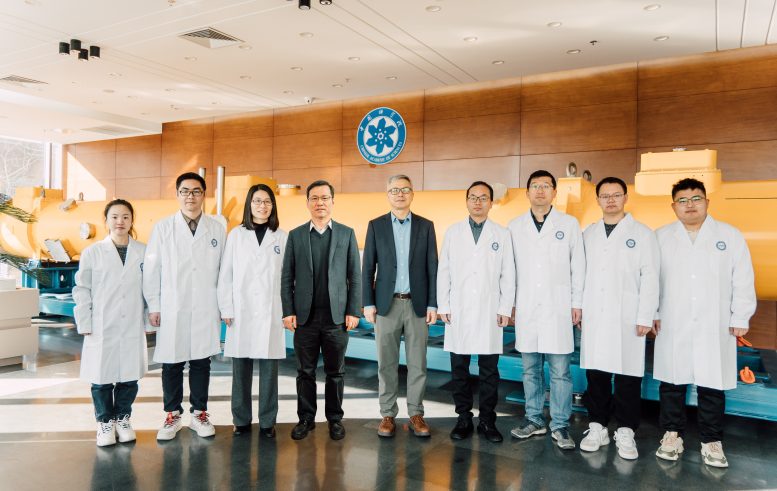博文
化学的新前沿:漫游反应打破旧的假设
 精选
精选
||
化学的新前沿:漫游反应打破旧的假设
诸平
Fig. 1 Roaming reaction pathway in highly excited states from vacuum ultraviolet photodissociation of sulfur dioxide was revealed by using the Dalian Coherent Light Source. Credit: DICP
Fig. 2 Bina Fu Team photo. Credit: DICP
据《科技日报》(SciTechDaily)网站2024年5月7日报道,来自中国科学院大连化学物理研究所(Dalian Institute Of Chemical Physics简称DICP, Chinese Academy Of Sciences)的消息,化学的新前沿:漫游反应打破旧的假设(A New Frontier in Chemistry: Roaming Reactions Shatter Old Assumptions)。
科学家们第一次观察到所谓的漫游化学反应(‘roaming’ chemical reactions),即在某些点上远离最小阻力的最低能量路径,进入高激发态。化学反应应该沿着它们的最小能量路径发生。近年来,人们开始观察到远离这条路径的所谓漫游反应(roaming reactions),但仅限于处于基态或最多处于第一激发态的化学物质。然而,研究人员现在已经观察到即使在高激发态下也存在漫游反应。
中国科学院( Chinese Academy of Sciences简称CAS)大连化学物理研究所(DICP)的研究人员,2024年2月15日发表在《科学》(Science)杂志上的一篇论文中描述了他们的发现。论文详见:Zhenxing Li, Yan-Lin Fu, Zijie Luo, Shuaikang Yang, Yucheng Wu, Hao Wu, Guorong Wu, Weiqing Zhang, Bina Fu, Kaijun Yuan, Donghui Zhang, Xueming Yang. Roaming in highly excited states: The central atom elimination of triatomic molecule decomposition. Science, 15 Feb 2024, 383(6684): 746-750. DOI: 10.1126/science.adn3357. https://www.science.org/doi/10.1126/science.adn3357
化学反应动力学(Chemical Reaction Dynamics)
直到最近,化学家们一直认为化学反应是沿着他们所谓的最小能量路径发生的,即在分子的起始稳定构型和最终稳定状态之间使用最少能量的反应路径。在任何化学反应的某一点上,都存在一个过渡态,在这个过渡态上势能有一个最大值。这可以被认为类似于一个球在山上滚上滚下。但山顶的过渡状态仍然位于最小能量路径上。反应不应该偏离这条阻力最小的路径。
但在2004年,研究人员在探索甲醛(formaldehyde)受到光子轰击时的分解(一种称为光解的化学反应)时,震惊地发现,有些化学反应实际上可以偏离最小能量路径。
这种偏离,或者更恰当地说,漫游(“roaming”),发生在预期的化学键分裂受挫时:一个分子的一个组成部分开始逃离母体分子,但发现它没有足够的能量这样做。因此,该组分只是以非最低能态围绕剩余的分子片段运行。它继续这个轨道,直到它撞到另一个分子的反应位点(一个分子上发生反应并形成新化学键的物理位置),回到最小能量路径。
从那以后,人们发现这些漫游反应不仅仅是偶尔发生,而是很常见。
上述论文的通讯作者之一、大连化学物理研究所的傅碧娜(Fu Bina)说:“事实证明,漫游是化学反应的一个普遍方面,以前从未被注意到。”
最新发现及意义(Recent Findings and Significance)
进一步的研究已经观察到漫游反应在基态(分子可能的最低能量)和第一激发态。当吸收能量时,分子中的电子跃迁到更高的能级,称为激发态。但漫游只在第一个这样的激发态中被观察到,而在随后的任何更高的激发态中都没有。漫游也没有被观察到导致化学反应产生电子激发的产物。
然而,这篇论文的作者报告说,他们第一次观察到在高度激发态下漫游,在这种情况下,二氧化硫(SO2)分子光解成硫和氧(一个SO2分子在受到光轰击时分解成一个硫原子S和一个氧分子O2)。

他们的研究结果揭示了两种可能的解离途径。一个沿着预期的最小能量路径产生振动温度较低(“vibrationally colder”)的O2分子,另一个在电子激发态产生振动温度较高(“vibrationally hotter”)的O2分子。
DICP的上述论文的另一位通讯作者袁开军(Yuan Kaijun)说:“后一种反应是通过一种漫游途径实现的,其中包括一种单一氧原子的斑点,我们称之为分子内O-抽象(‘intramolecular O- abstraction’),在分子重新定向的运动中。”
任何时候遇到受挫键劈裂的可能性增加,在高激发态漫游反应和产生电子激发态产品的可能性就增加。研究人员相信,这种漫游动力学可能会成为规律,而不是分子通过高激发态光解的例外。
考虑到SO2在地球大气中的重要性,研究人员对其特别感兴趣。SO2丰度的变化影响地球的辐射平衡,从而影响气候,而火山喷发产生的SO2是平流层中气溶胶的两个最重要来源之一,电子激发的产物本身在大气、空间和燃烧中的反应非常不同。最后,SO2的光解作用对于了解生命出现之前地球原始大气中分子氧(O2)的来源具有重要意义。
由于他们的发现,研究人员认为,分子氧产生的漫游机制现在应该被纳入具有丰富的火山释放SO2的行星大气的光化学模型中。
上述介绍,仅供参考。欲了解更多信息,敬请注意浏览原文或者相关报道。
Roaming is an important reaction mechanism that does not follow a minimum energy pathway and thus bears specific signatures in product state distributions. Over the past two decades, much experimental evidence has been found for roaming in both ground and first excited states of polyatomic molecules. Given the complex electronic structure and multiple product channels, roaming should be more common in highly excited electronic states, but experimental evidence has been lacking. Li et al. demonstrated that roaming is important for sulfur dioxide photodissociation from highly excited states. The experimental data were supported by full-dimensional dynamics simulations. The present work confirms that roaming should be expected to be a fairly common phenomenon in dynamics of highly excited states. —Yury Suleymanov
Chemical reactions are generally assumed to proceed from reactants to products along the minimum energy path (MEP). However, straying from the MEP—roaming—has been recognized as an unconventional reaction mechanism and found to occur in both the ground and first excited states. Its existence in highly excited states is however not yet established. We report a dissociation channel to produce electronically excited fragments, S(1D)+O2(a1Δg), from SO2 photodissociation in highly excited states. The results revealed two dissociation pathways: One proceeds through the MEP to produce vibrationally colder O2(a1Δg) and the other yields vibrationally hotter O2(a1Δg) by means of a roaming pathway involving an intramolecular O abstraction during reorientation motion. Such roaming dynamics may well be the rule rather than the exception for molecular photodissociation through highly excited states.
https://blog.sciencenet.cn/blog-212210-1433401.html
上一篇:经常在食物中加盐会增加患胃癌的风险
下一篇:败血症新药

